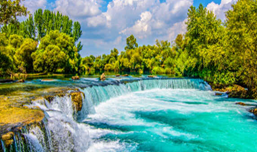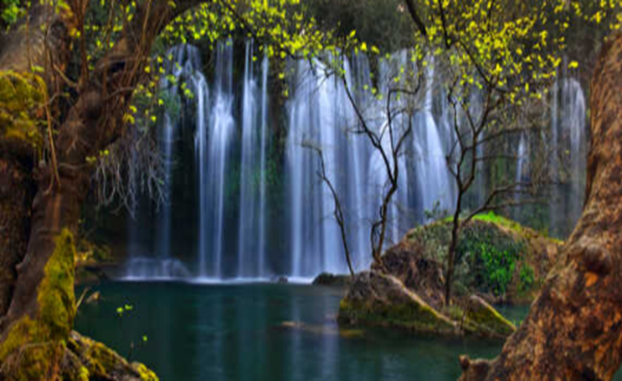About Antalya
History
During the Hellenistic period, King Attalos II of Pergamon ( 159-138 BC) said to his soldiers “Go and find me heaven on earth”. Attalos II, who liked the place shown by his soldiers, had a port city established here, taking into account the strategic importance of the region, and the city was named “Ataleia” in honor of its founder Attalos. Ateleia means “Home of Attalos“.
Antalya and its surroundings have the legacy of both lifestyles that have been filtering through the centuries. When the Turks first came here, they immediately adapted to the settled order and established villages, towns and cities. A part of the population, on the other hand, continued to live a nomadic life as they did before the Turks came to Anatolia.
They raised animals such as camels and sheep and made a living by exchanging or selling their products with the products of the settled people. They produced meat, milk and oil, and wove hair tents and natural root dyed rugs. There were even those who planted grains and vegetables in narrow areas in winter quarters. There were even large groups of nomads (tribes, clans) who raised horses for the Ottoman army.
Natural Beauties
Manavgat Waterfall: It is located in the Manavgat district of Antalya. In the waterfall, which has a magnificent view of nature, various nature sports such as rafting and canoeing can be done in certain stages of the river, which allows you to experience adventure in nature landscapes.

Saklikent Canyon: Saklikent Canyon, located between the borders of Antalya and Fethiye, has a total length of 18 kilometers. If you want to plan a trip intertwined with nature, you can also see the forested areas formed by red pine, cedar and larch trees in Saklikent Canyon, where you can have a very pleasant time.

Kursunlu Waterfall Nature Park: It is located on the borders of Aksu district of Antalya. The Kurşunlu Waterfall, where 7 ponds merge and spill, falls from a height of about 20 meters. The waterfall, which is one of the indispensable parts of Antalya vacation with its refreshing effect and the resulting view, was opened to visitors as a natural park in 1991.

Goynuk Canyon: It is located in Kemer district of Antalya. It is located on the Lycian Way, which is shown as one of the world’s top 10 long-distance walking routes by various sources. The pond creates an impressive landscape with its lush green waters.

Köprülü Canyon National Park: Located in the Bozyaka neighborhood of Manavgat district, Köprülü Canyon National Park is 25 km long. Köprülü Canyon, which impresses visitors with its natural beauty, is Turkey’s most popular rafting area. Rafting is a fun and exciting river sport practiced in high-flow rivers with boats called rafts.

Kekova Island: It is located in the Demre district of Antalya. There is no construction on Kekova Island, where you can both enjoy the sea and organize historical excursions during your Mediterranean holiday. There are also sunken ancient cities around the island, which offers a very impressive visual feast with its turquoise sea.

Incekum Nature Park: It is located in Alanya district of Antalya. It stands out among the important natural beauties of Antalya. Located at a unique point where the greenery of the forests meets the blue of the Mediterranean, the park is one of the ideal spots to spend time away from city life and calmly.

Çıralı Yanartaş: It is located in the Kemer district of Antalya. Çıralı Yanartaş, located at the foot of Çataldağ, one of the natural beauties of Kemer, has very impressive features. The fire burns 24 hours a day in the region where methane gas can be seen constantly burning between the rocks on the top.

Duden Waterfall: Duden Waterfall is one of the most visited tourism centers of Antalya due to its fascinating natural beauty. According to a rumor in 334 BC, it is said that the commander Alexander the Great watered his horses here on his way to conquer the Pamphylia region. There are 2 waterfalls, Lower and Upper Duden.

Tazı Canyon: It is a canyon valley located in the Manavgat district of Antalya province. Tazı Canyon, located within the boundaries of Köprülü Canyon National Park, was formed by the erosion of the valley by the Köprüçay River. It is estimated that the formation of the canyon dates back to the ice age. As a result of the melting of the ice masses by separating from each other and creating erosion with great energy and releasing itself into the valleys, it was formed by hollowing out the limestone rocks in non-calcareous areas. The length of the canyon is 4 km.

In order to protect our nature, make sure to choose environmentally friendly products such as sunscreen, perfume, skin care products and the like,
Keep in mind that sunscreen chemicals that end up in our oceans can harm undersea creatures.
Historical Places
Kaleiçi has many cultural heritage such as Old Antalya Houses, Yivli Minaret, Şehzade Korkut Mosque, Karatay Madrasah, Perge Ancient City, Karain Cave, Hadrian’s Gate, Phaselis Ancient City, Phaselis, Aspendos Theater, Xanthos Ancient City, Alanya Castle, Myra Ancient City, Temple of Apollo, Olympos Ancient City.
Agriculture and Livestock
Various agricultural products are grown in the fertile lands of the Antalya region. Wheat, barley and oats are the most common agricultural products. In addition, cotton, sesame, onion, peanut, chickpea and vegetables are grown on 35 thousand hectares. It is the most advanced province in greenhouse cultivation. In 32 thousand hectares of greenhouses, tomatoes, peppers, beans, eggplants, cucumbers, melons and watermelons are grown. They are sold at home and abroad. Antalya is very advanced in fruit growing. Antalya is the province where most bananas and oranges are grown. In addition, apples, pears, plums, quinces, peaches, apricots, grapes, grapes, carob, cranberries and other fruits are grown. Tangerines, lemons, grapefruit are the main source of income in Antalya, and olive cultivation is also highly developed in addition to citrus production.
Antalya region, with its climatic features and rich vegetation, brings with it the richness of wildlife. Deer, foxes, martens, squirrels, fallow deer, wild goats, jackals, hyenas, wolves, bears, partridges, quail, steppe, wild pigeons, woodcock, turac, blackbirds, blackbirds, orioles and cranes constitute the main wildlife of the province.
Protected Plant and Animal Species
- Mediterranean monk seals, sea turtles and loggerhead turtles are protected in these regions.
- Plant species such as cyclamen, iris, sand lily, daffodil and crocus are also among the protected species.
- You should not buy souvenirs made from protected plant and animal species.
- Hunting sports are prohibited except for the dates permitted by the Ministry of Agriculture and Forestry.
- We kindly ask you not to participate in activities that separate animals from their natural habitat such as circus and dolphin shows.
National and Religious Values
- April 23rd National Sovereignty and Children’s Day, May 19th Commemoration of Atatürk Youth and Sports Day, August 30th Victory Day and October 29th Republic Day are among our national values
- Ramadan and Eid al-Adha are among religious values.
How to Behave in Religious Places
We are obliged to follow some rules in mosques where we perform our religious worship,
- Shoes/slippers etc. are not allowed in the mosque
- For women, the hair is covered with a headscarf/veil etc. and care should be taken to ensure that the clothing covers the body,
- There should be no loud talking,
- Other people should be respected.
National Anthem
Rules to be followed when reading/hearing the National Anthem, our national anthem,
- If we have a hat on our head, we should take it off.
- If we are sitting, we should get up and show respect.
- We must not leave our seats until we hear the end of the anthem.
- We should not be busy with anything while singing and listening to the National Anthem
- We must not laugh or be disrespectful during the anthem.
Rules to be followed in Ruins, Historical Sites and Museums
- Do not touch or write on the artifacts and their cases (pedestals) exhibited in museums and archaeological sites.
- Do not make noise,
- Listen carefully and ask your guide and museum education specialists (if any) any questions you may have.
- Please pay attention to the warnings given at the museum/excursion site.
- Do not eat anything in the museum/exploration site.
- Do not litter on the ground.
- Follow the rules of the museum you visit about taking photos in the museum.
- Do not climb on/contact historical ruins in open-air museums/ceremonies.
Traditional Crafts and Crafts in Antalya
Antalya, which has been a cultural basin throughout its history and preserves this feature today, also draws attention with the diversity of traditional handicrafts. Some of the handicrafts identified as a result of field research carried out on various dates in our city can be listed as follows;
- Wooden Boat Building
- Coppersmithing
- Knife making
- Instrument Making
- Bell Production
- Dowry Chest Making
- Sock Knitting
- Blacksmithing
- Tumbler Fığla Tumbler Making
- Gilamik Weaving
- Carpet Weaving
- Silk Weaving
- Tinsmithing
- Spooning
- Rug Weaving
- Kolan (Multiplier) Weaving
- Needlework
- Gourd Embroidery
- Quilt Making
Local Folk Dances
The folk dances of Antalya region have a regional characteristic called “Teke Folklore”. As in the field of music, the influence of Yoruks is predominant in folk dances in the region. The dances of the region consist of dances such as Mengi, Samah, Teke, Spoon dances and Zeybek, which the dancers perform without holding on to each other. In the districts to the east of Antalya, Konya spoon dances, Bosphorus dances, Serenler Zeybeği, Anamur Roads, Silifke’s Yogurt and Cezayir dances are played. These dances are also played individually or collectively.
Local Food
The diet of nomads is based on animal husbandry and wheat-based foods. Although a small amount of fresh vegetables are produced on the coastline, wheat and dried vegetables gain weight as you go inland. In Antalya, it is possible to find all of the world cuisines in touristic hotels and restaurants. Local dishes unique to the region are as follows: Hair roast, Tandoori kebab, Kölle (boiled wheat, beans, chickpeas and broad beans), Tomato civesi, Hibeş, Arapaşı
Sport
There are many registered sports clubs and around 200,000 licensed athletes within the province. These clubs are active in many sports including football, basketball, handball, volleyball, athletics, wrestling, judo, karate, taekwondo, tennis, table tennis, water polo and swimming. Antalyaspor, which uses the nickname Scorpions in football, represents the city at the highest level in Turkish football. Antalyaspor plays its matches at the 33,032-seater Antalya Stadium.
Festivities and Festivals
Festivals and festivals are organized in Antalya in various periods. These festivals are generally summer festivals in the highlands of Antalya (such as Feslikan Plateau Festival, Söbüce Plateau Festival, Alanya Festivals). In addition, people living in the Alevi-Bektashi-Turkmen culture in the Elmalı region also organize festivals (such as Abdal Musa Festivals).In Antalya, festivals are organized on a national and international scale as well as on a local scale. The biggest festival on a national scale is the Antalya Television Awards, which started to be organized in 2010. On an international scale, the Antalya Golden Orange Film Festival is organized every year in October. In addition, the International Antalya Sand Sculpture Festival is the only traditional sand sculpture event in Turkey and one of the largest sand sculpture events in the world.
While carrying out all these activities; do not neglect the personal care areas of women and children.
We kindly ask you to be especially tolerant towards children and to avoid any behavior that may harm them.
